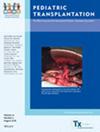Epstein–Barr virus‐associated post‐transplant lymphoproliferative disorders in pediatric transplantation: A prospective multicenter study in the United States
IF 1.2
4区 医学
Q3 PEDIATRICS
引用次数: 0
Abstract
BackgroundEpstein–Barr virus (EBV)‐associated post‐transplant lymphoproliferative disorders (PTLD) is the most common malignancy in children after transplant; however, difficulties for early detection may worsen the prognosis.MethodsThe prospective, multicenter, study enrolled 944 children (≤21 years of age). Of these, 872 received liver, heart, kidney, intestinal, or multivisceral transplants in seven US centers between 2014 and 2019 (NCT02182986). In total, 34 pediatric EBV+ PTLD (3.9%) were identified by biopsy. Variables included sex, age, race, ethnicity, transplanted organ, EBV viral load, pre‐transplant EBV serology, immunosuppression, response to chemotherapy and rituximab, and histopathological diagnosis.ResultsThe uni−/multivariable competing risk analyses revealed the combination of EBV‐seropositive donor and EBV‐naïve recipient (D+R−) was a significant risk factor for PTLD development (sub‐hazard ratio: 2.79 [1.34–5.78],小儿移植中与爱泼斯坦-巴氏病毒相关的移植后淋巴组织增生性疾病:美国一项前瞻性多中心研究
背景与爱泼斯坦-巴氏病毒(EBV)相关的移植后淋巴组织增生性疾病(PTLD)是儿童移植后最常见的恶性肿瘤;然而,早期检测困难可能会使预后恶化。其中872名儿童在2014年至2019年期间在美国的7个中心接受了肝脏、心脏、肾脏、肠道或多脏器移植(NCT02182986)。活检共发现34例小儿EBV+ PTLD(3.9%)。变量包括性别、年龄、种族、民族、移植器官、EBV病毒载量、移植前EBV血清学、免疫抑制、对化疗和利妥昔单抗的反应以及组织病理学诊断。结果 单变量/多变量竞争风险分析显示,EBV血清学阳性供体和EBV未感染受体(D+R-)组合是PTLD发生(亚危险比:2.79 [1.34-5.78],p = .006)和EBV DNA血症(2.65 [1.72-4.09],p <.001)的重要风险因素。D+R-患者与单形/多形PTLD的相关性明显高于其他组合(p = .02)。单形/多形 PTLD 患者(n = 21)的 EBV DNA 血症明显多于非 PTLD 患者(p <.001),而且在移植后 6 个月内,PTLD 的临床表现早于增生患者(p <.001)。结论D+R-是PTLD和EBV DNA血症的危险因素,与单形/多形PTLD的发病率有关。移植后6个月内加强EBV病毒载量随访,尤其是对D+R-患者和/或移植时年龄≥5岁的非肝移植受者进行随访,有助于在儿科移植早期发现单形/多形性PTLD。
本文章由计算机程序翻译,如有差异,请以英文原文为准。
求助全文
约1分钟内获得全文
求助全文
来源期刊

Pediatric Transplantation
医学-小儿科
CiteScore
2.90
自引率
15.40%
发文量
216
审稿时长
3-8 weeks
期刊介绍:
The aim of Pediatric Transplantation is to publish original articles of the highest quality on clinical experience and basic research in transplantation of tissues and solid organs in infants, children and adolescents. The journal seeks to disseminate the latest information widely to all individuals involved in kidney, liver, heart, lung, intestine and stem cell (bone-marrow) transplantation. In addition, the journal publishes focused reviews on topics relevant to pediatric transplantation as well as timely editorial comment on controversial issues.
 求助内容:
求助内容: 应助结果提醒方式:
应助结果提醒方式:


